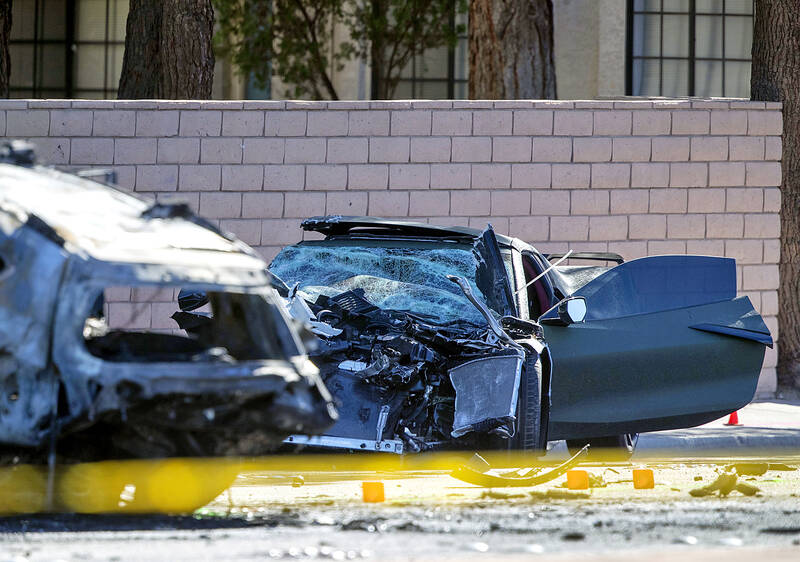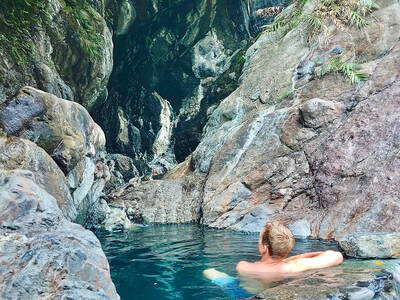Police and driving instructors in Japan have adopted an unorthodox approach to road safety in the hope of reducing incidences of drink-driving — by allowing drivers to consume alcohol before getting behind the wheel.
Chikushino driving school in the south-western city of Fukuoka recently began offering controlled drink-driving experiences as part of a police campaign to convince “overconfident” motorists never to drink and drive.
The initiative was launched around the 17th anniversary of the deaths of three children from the city — two boys aged four and three, and their one-year-old sister — who died when their family car was struck by a municipal government employee who was driving under the influence of alcohol.

Photo: AP
Drivers taking part in the recent experiment included two reporters from the Mainichi Shimbun — one who drank and drove, and another who observed her colleague as a sober passenger.
The drivers were first asked to negotiate three sections of road — a slalom, an S-bend and a series of tight curves — while sober. The newspaper reporter, Hyelim Ha, then drank a 350ml can of beer, as well as a cup each of umeshu plum wine and shochu spirit — both mixed with water — over the course of about an hour.
A breathalyser test on Ha detected 0.30mg of alcohol per liter of breath, twice the threshold of 0.15mg, the newspaper said.
Despite having cold hands, a raised heart rate and red face, Ha said she felt able to drive — a sentiment reportedly expressed during questioning by the driver who caused the fatal collision in 2006.
Ha’s confidence was misplaced. Her fellow reporter, Rokuhei Sato, lurched back and forth as Ha repeatedly accelerated and slowed down unnecessarily along a straight section of road. She managed to clear the bollards on the slalom course, but was brought to a halt by the school’s vice head, Shojiro Kubota, before she took on the S-bend.
To Ha’s apparent surprise, Kubota told her she had entered a curve at a higher speed after drinking, and at one point had strayed into the opposite lane.
“Even though [drinking] impairs the skills people need for driving, such as cognitive capacity, judgment and vehicle maneuvering ability, the driver assumes they are driving safely — that’s the danger of drink-driving,” Kubota said, according to the Mainichi.
Japan’s national police agency says that many drivers who drink and drive without incident develop a sense of invincibility and continue to repeat the same dangerous behaviors.
It cited data showing that the probability that a road traffic accident will involve a death is seven times higher when the driver has drunk alcohol compared with accidents in which the driver is sober.
“We are calling on people to properly manage the risks before drinking, such as not driving to the pub in the first place, on the premise that once they are drunk, they are unable to make normal judgments,” Yoichi Furukawa, deputy chief of the prefectural police’s traffic enforcement division, told the newspaper.

Exceptions to the rule are sometimes revealing. For a brief few years, there was an emerging ideological split between the Democratic Progressive Party (DPP) and Chinese Nationalist Party (KMT) that appeared to be pushing the DPP in a direction that would be considered more liberal, and the KMT more conservative. In the previous column, “The KMT-DPP’s bureaucrat-led developmental state” (Dec. 11, page 12), we examined how Taiwan’s democratic system developed, and how both the two main parties largely accepted a similar consensus on how Taiwan should be run domestically and did not split along the left-right lines more familiar in

As I finally slid into the warm embrace of the hot, clifftop pool, it was a serene moment of reflection. The sound of the river reflected off the cave walls, the white of our camping lights reflected off the dark, shimmering surface of the water, and I reflected on how fortunate I was to be here. After all, the beautiful walk through narrow canyons that had brought us here had been inaccessible for five years — and will be again soon. The day had started at the Huisun Forest Area (惠蓀林場), at the end of Nantou County Route 80, north and east

Specialty sandwiches loaded with the contents of an entire charcuterie board, overflowing with sauces, creams and all manner of creative add-ons, is perhaps one of the biggest global food trends of this year. From London to New York, lines form down the block for mortadella, burrata, pistachio and more stuffed between slices of fresh sourdough, rye or focaccia. To try the trend in Taipei, Munchies Mafia is for sure the spot — could this be the best sandwich in town? Carlos from Spain and Sergio from Mexico opened this spot just seven months ago. The two met working in the

This month the government ordered a one-year block of Xiaohongshu (小紅書) or Rednote, a Chinese social media platform with more than 3 million users in Taiwan. The government pointed to widespread fraud activity on the platform, along with cybersecurity failures. Officials said that they had reached out to the company and asked it to change. However, they received no response. The pro-China parties, the Chinese Nationalist Party (KMT) and Taiwan People’s Party (TPP), immediately swung into action, denouncing the ban as an attack on free speech. This “free speech” claim was then echoed by the People’s Republic of China (PRC),